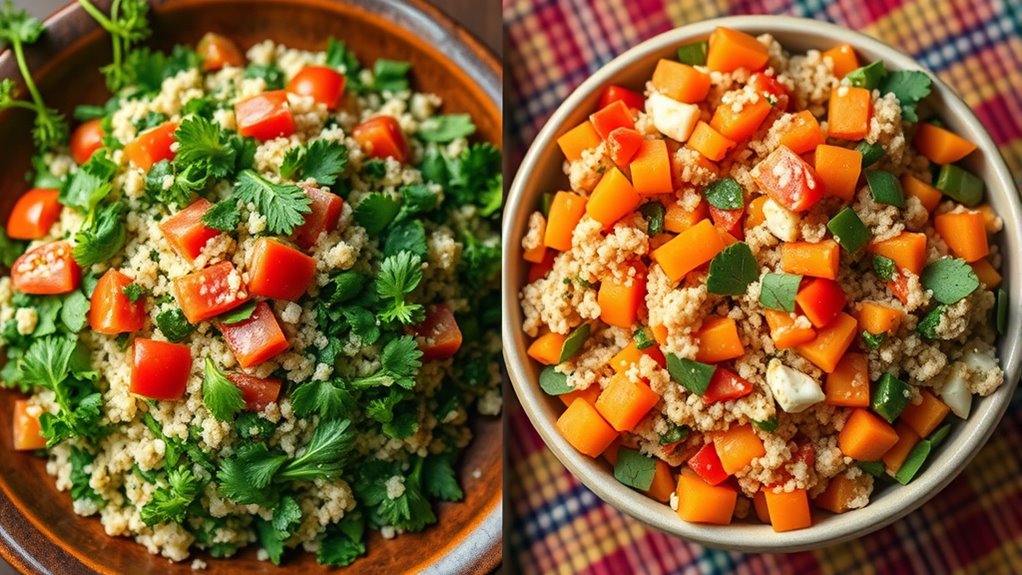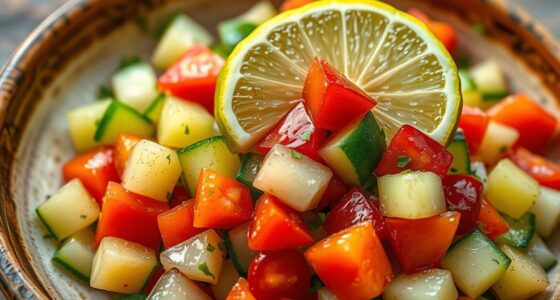Lebanese Tabbouleh highlights regional traditions with its finely chopped parsley, tender bulgur, and simple lemon dressing, reflecting the Middle East’s emphasis on herbs as a central ingredient. In contrast, Brazilian Tabule features a vibrant mix of herbs like cilantro and parsley, often with a crisper texture and looser presentation, showcasing Brazil’s relaxed culinary style. Exploring these differences reveals how culture shapes the ingredients and preparations; uncover more details by continuing your exploration.
Key Takeaways
- Lebanese Tabbouleh emphasizes finely chopped parsley and mint, reflecting Middle Eastern herb-centric culinary traditions.
- Brazilian Tabule incorporates a mix of parsley and cilantro, showcasing regional diversity and a preference for vibrant, flexible salads.
- Lebanese Tabbouleh uses tender, cooked bulgur and is part of traditional mezze, highlighting its cultural role as a palate cleanser.
- Brazilian Tabule favors a crisper, salad-like presentation with larger portions, aligning with Brazil’s casual, versatile dining style.
- The preparation and presentation styles of each dish mirror their cultural identities—refined and traditional versus relaxed and colorful.

Have you ever wondered how Lebanese Tabbouleh and Brazilian Tabule differ despite sharing similar names and fresh, herbaceous flavors? The answer lies in their distinct herb variations and serving styles, which reflect their unique cultural backgrounds. When you explore Lebanese Tabbouleh, you’ll notice that it emphasizes a generous amount of finely chopped parsley, often with a hint of mint. The focus on herbs is central to the dish, making it a vibrant, green salad that highlights the herb’s fresh, aromatic qualities. The bulgur wheat in Lebanese Tabbouleh is usually cooked to a tender consistency and blended harmoniously with the herbs, lemon juice, olive oil, and sometimes tomatoes. This combination results in a salad that’s both revitalizing and hearty, often served as part of mezze spreads or alongside grilled meats.
In contrast, Brazilian Tabule showcases a different approach to herb variations and serving styles. While it shares the herbaceous character, it typically incorporates a mix of fresh herbs like parsley and cilantro, which give it a distinct flavor profile. The emphasis isn’t solely on parsley as in Lebanese Tabbouleh; instead, you’ll find a broader spectrum of herbs that lend a more complex, vibrant taste. The preparation style leans toward a crisper, more salad-like texture, often served chilled as a standalone dish or a side. The bulgur in Brazilian Tabule tends to be less prominent or sometimes replaced by rice or other grains, aligning with regional preferences for lighter, more flexible dishes.
The serving styles of these two dishes also diverge markedly. Lebanese Tabbouleh is traditionally presented as part of a mezze platter, chopped finely and mixed thoroughly before serving. It’s meant to be eaten with pita bread or as an accompaniment to grilled dishes, emphasizing its role as a fresh, palate-cleansing side. Brazilian Tabule, however, often appears as a colorful, more casual side dish or salad, served in larger portions and enjoyed as a main or side item. It’s more likely to be served chilled in a bowl, sometimes topped with additional herbs or vegetables for visual appeal and flavor.
Ultimately, your experience with these salads will reveal their cultural distinctions through herb variations and serving styles. Lebanese Tabbouleh’s focus on parsley and meticulous presentation contrasts with Brazilian Tabule’s broader herb mix and relaxed, versatile serving approach. Each offers a unique taste of its region’s culinary identity, showcasing how a simple dish can embody diverse traditions and flavor profiles.
Frequently Asked Questions
How Do Ingredient Variations Reflect Regional Agricultural Practices?
You notice ingredient variations reflect regional agricultural influences, with Lebanese Tabbouleh featuring bulgur and parsley from local farms, while Brazilian Tabule uses fresh herbs and produce suited to regional agriculture. These differences show how regional produce shapes recipes, adapting to what’s available locally. By using ingredients that thrive in each area’s climate and soil, both dishes celebrate regional agricultural practices and reflect local culinary traditions.
What Are the Historical Origins of Lebanese and Brazilian Versions?
You might think Lebanese tabbouleh dates back to ancient Phoenician times, but its culinary evolution actually reflects centuries of Middle Eastern cultural influences, blending herbs and grains for health and flavor. Brazilian tabule, influenced by Arab immigrants, adapts this tradition with local ingredients, showcasing how culinary evolution bridges regions. Both dishes reveal how cultural exchanges and historical migrations shape food, creating vibrant, regional identities through shared culinary roots.
How Do Preparation Methods Influence Traditional Cultural Significance?
Your preparation methods deeply influence cultural symbolism and rituals, highlighting the dish’s significance. In Lebanese Tabbouleh, you might focus on finely chopping herbs and mixing with olive oil, reflecting a respect for tradition. Brazilian Tabule often involves vibrant presentation, emphasizing communal sharing. These preparation rituals honor cultural values, strengthen community bonds, and preserve culinary heritage, making each dish more than just food — it’s a symbol of identity and history.
Are There Specific Occasions When Each Dish Is Traditionally Served?
Imagine a colorful tapestry woven with vibrant threads—that’s how Lebanese Tabbouleh and Brazilian Tabule are traditionally served during festive occasions and daily meals. You’ll find Lebanese Tabbouleh often gracing family tables during celebrations like Eid, symbolizing unity, while Brazilian Tabule brightens everyday lunches, reflecting simplicity and freshness. These dishes hold special cultural significance, making each occasion more memorable with their unique flavors and traditions.
How Do Linguistic Differences Affect the Naming and Perception of the Dishes?
Linguistic nuances influence how you perceive and name these dishes. When you hear “tabbouleh,” you might associate it with Lebanese cuisine, shaping your expectations and perceptions. Similarly, “tabule” in Brazil reflects local linguistic influences, possibly altering its perceived authenticity. These naming perceptions affect how you view the dish’s cultural origins, often blending linguistic differences with cultural identity, which in turn shapes your overall impression of each version.
Conclusion
As you compare Lebanese tabbouleh with Brazilian tabule, you’ll notice how culture shapes even the simplest dishes. Coincidentally, both nations embrace fresh herbs and vibrant flavors, yet their unique traditions turn these ingredients into distinct culinary stories. It’s a reminder that food reflects not just taste, but the history and heart of a people. So, next time you enjoy a bowl, think about how food unexpectedly connects cultures across the world.








